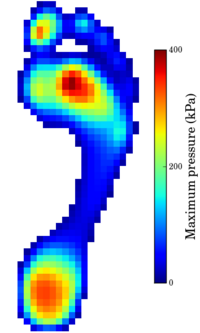
Photo from wikipedia
Background Few previous studies focused on plantar loading patterns in HV patients with metatarsalgia. Are there any differences in plantar pressure measurements in women with HV with and without metatarsalgia?… Click to show full abstract
Background Few previous studies focused on plantar loading patterns in HV patients with metatarsalgia. Are there any differences in plantar pressure measurements in women with HV with and without metatarsalgia? Methods A prospective matched-cohort study was designed to analyze plantar pressure measurements in women with HV with and without metatarsalgia from January 2017 to December 2019. The inclusion criteria were age over 18 years old, women, diagnosis of HV with metatarsalgia. Control group had the same inclusion criteria, except metatarsalgia. Patient-reported outcomes scores included American Orthopedic Foot and Ankle Society Score (AOFAS), and Visual Analog Scale (VAS). Radiographic data were obtained according to the guidelines of the AOFAS Committee on Angular Measurements. Plantar pressure measurements were performed using a platform. Results Forty-seven patients met the inclusion criteria. An age-, BMI-, and hallux valgus angle-matched cohort of 47 patients were also selected. There were no statistically significant differences in demographic data and radiographic assessment. HV with metatarsalgia group showed greater values in peak and mean force, peak and mean pressure, and pressure-time integral under toes and metatarsal heads. These differences reached statistically significant in mean force (p = 0.009) and peak force (p = 0.003) under T1; mean pressure (p = 0.01) and peak pressure (p = 0.04) under T1; and mean force (p = 0.003) under MH1. The binary logistic regression analysis showed mean force under T1 as the most associated plantar pressure measurement with the presence of metatarsalgia. C-statistic was 0.66. Mean force > 35 N had a 70% of sensitivity and a 57% of specificity as a cut-off value for the presence of metatarsalgia. Conclusion HV patients with metatarsalgia had greater values in plantar pressure measurements. Mean force under T1 could be used as a plantar pressure measurement to predict metatarsalgia.
Journal Title: Indian journal of orthopaedics
Year Published: 2021
Link to full text (if available)
Share on Social Media: Sign Up to like & get
recommendations!